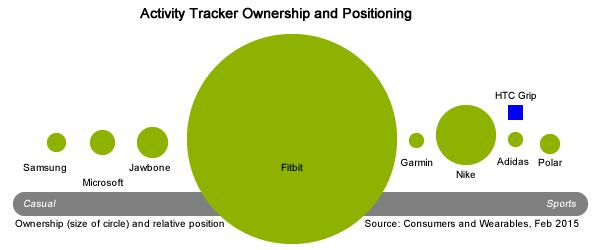HTC has taken its first bold step into the wearables space, with the launch of the HTC Grip. The activity tracker is the first product to come out of the partnership HTC announced with Under Armour at CES in January. And importantly, the product looks like an Under Armour product thanks to its color scheme, and works directly with UA’s Record app, rather than having its own proprietary app.
The collaboration with the UA Record app is both a given (based on the partnership) but is also a major benefit for the new hardware. One of the major challenges with new activity tracker hardware is building the app-based community to provide a social aspect and increase consumer stickiness. With between 120 and 130 million subscribers, UA Record comes with a rather significant community and – by association – a natural target audience to sell the product to.
Clearly there are a plethora of activity trackers already in the market, but the HTC differentiates in two (related) ways. Firstly, the device includes GPS and is fairly waterproof, which broadens the number of sports that it can support (this is not just a step counter). Additionally, the Grip will also connect to heart rate monitor peripherals to provide a more complete picture. Secondly (and related) this device is focused on the sports-end of the market, rather than the more casual user. As such, this competes more against the Nike Fuelband than against the Fitbit band: the Grip screams “I’m sporty” when worn, just as the Fuelband did. The nearest current competition to the new Grip is Adidas’ Fit Smart, which is an activity tracker that includes heart rate, but not GPS. As such, the two products veer apart from each other and consumers will be split by the need for one – or both – of these key features. And both have compelling brands that address the sports-focus.
While the Grip is a sports-first tracker, it still comes with key smartphone interaction, including call and message alerts and calendar options. This includes the all-important silent alarm, which is a key feature for 24/7 use. Talking of which, the battery life is a little more challenging than many devices: it is 2.5 days of normal use, and just 5 hours of GPS use. Clearly this is far less than most other devices, but the compromise was worthwhile to build a band than is slim and light, rather than bulking it up. This may mean that consumers should plan not to track sleep with the device and get into the mindset of charging every night. Not ideal, but again, this is a sports/performance-first device, rather than a generic wellness product.

At $199, the now Grip is at the high end of the activity tracker market (most current bands are sub-$150) but the addition of GPS will help the device to stand out. Only Microsoft’s Band offers GPS in a band format currently; typically you need to upgrade to a watch for this functionality.
The most interesting challenge will be the retail environment, and this is where Under Armour should be able to help out. Clearly, a product like this needs to have a presence in the sporting goods stores. But location within the store is even more important. Currently, all the activity trackers are grouped together near the checkout. But this product needs to be grouped with the rest of the Under Armour products, demonstrating brand unity. This location will become even more important as additional products are launched that will – potentially – integrate the technology into the clothing. And, as with all wearable tech, retail location will be key to the device’s success. Of course, having 130 million UA Record users won’t hurt either…